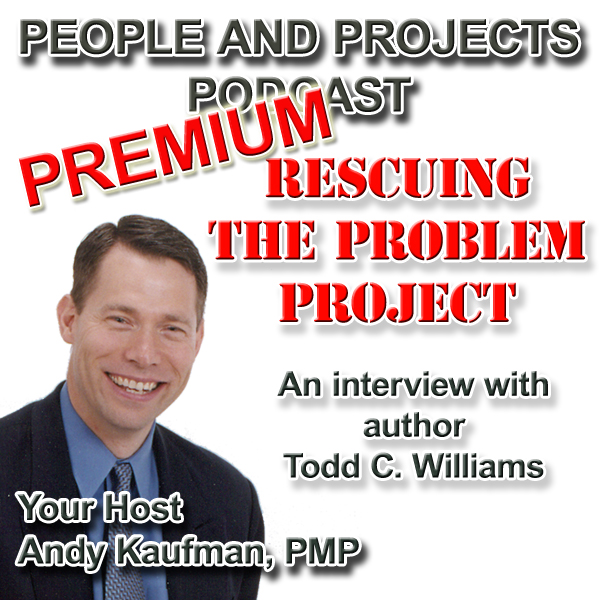Jul 26, 2011

There's nothing easy about rescuing a problem project. There's a reason why they're called problem projects! Todd's book is reasonably good at outlining a framework for how to approach the problem project when you inevitably will be tasked with doing so.
In this special premium edition, I want to share some coaching for you based on lessons from Todd's book.
First, let me encourage you to not back away from the problem projects. I talked with Todd about that early in the discussion. Though it may not be fun, per se, there's something engaging about the problem-solving of a problem project. If you can develop a reputation of taking on the chaos, bringing it under control, and delivering the project, it really is your chance to shine. It used to drive me crazy when I'd hear people say, "It's not a problem, it's an opportunity!" Let's call it what it is: it's a problem! However, it is an opportunity as well. Remember that when you're tempted to try and dodge a recovery effort.
Second, I have to ask: Do you have a project that needs to be acknowledged that it's in trouble? This is related to my discussion with Todd about the parallels with 12 step programs. According to Todd, the first step--acknowledging that we have a problem--is the biggest hurdle. He suggested that we be passionately dispassionate, which is an intriguing way of saying it. Todd suggests you stick to facts, and I agree. However, emotions are inevitably a part of the fabric of a recovery situation and being willing to attempt to understand and interpret those emotions might be helpful in uncovering the facts. When you lay facts on the table that can be backed up, you have immensely more credibility than the people who are freaking out that the sky is falling and it's someone else's fault!
Third, I really liked Todd's coaching that we match the methodology with the situation. In the book Todd compares and contrasts waterfall, agile, and critical chain. I actually think that chapter is potentially one of the most helpful parts of Todd's book. Tailoring an approach to the problem--selecting the best tool for the job--is one sign of a master craftsman (and great project manager).
Fourth, Todd gave some subtle coaching about how to pull the alarm, if necessary. He said it this way: "Here's what's wrong! Here's what's wrong! And here's what we can do to fix it." Notice how different that is than just "Here's what's wrong!" Come to the table with solutions, not just problems. That shows you're taking ownership and responsibility. It's just good leadership.
Finally, remember your assumptions. In our project management workshops we talk about how assumption planning is vital to project planning. Todd suggested that during recovery efforts, we should see if some of our assumptions are no longer valid. Assumptions drive so much and can teach us why a project is struggling. Make sure to uncover any missing assumptions as well as validate those assumptions that have been identified. Learn from assumptions that turned out to not be true, real, or certain and you can benefit future projects.
If you're heading into (or already in the midst of) a problem project, make sure to check out Todd's book: Rescue the Problem Project: A Complete Guide to Identifying, Preventing, and Recovering from Project Failure.
Hey, the People and Projects Podcast is now on Facebook! I invite you to Like us at http://www.facebook.com/pages/People-and-Projects-Podcast/224005747630357 and join the discussion.
Thank you for being a premium subscriber to The People and Projects Podcast! Please let me know what questions you have and if there's anything I can do to help you lead and deliver. Thank you for joining me for this premium episode of The People and Projects Podcast! Have a great week!
Total Duration 4:10





